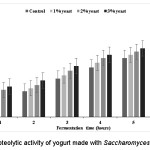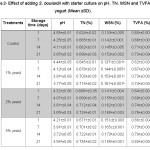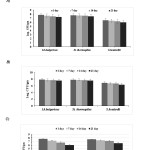Introduction
Saccharomyces boulardii was found by a French microbiologist, Henri Boulard in 1923 when he was in Indochina zone looked for new strains of yeast that could be used in fermenting processes. Saccharomyces boulardii isolated from Lychees fruit (Litchi chinensis) and Mangosteen fruit (Garcinia mangostana) grown in tropics warm as Indochina.1 It is eukaryotic, single-cell, yeast cell diameter is between 2-3 μm and length is between 2.5-10.5 μm, the yeast cells non-sexual reproduction by budding method or sexual reproduction by cells conjugation, which be Ascus. S. boulardii has an optimal high growth temperature at 37oC.2
boulardii yeast is one member of probiotics as a live in human gastrointestinal and used to variety of diarrheal treatment with antibiotic.3 This yeast secretes many enzymatic proteins, including an enzyme that inhibition for Clostridium difficile toxins and phosphatase enzyme (EC 3.1.3.X) that depressed activity endotoxin production from Gram-negative bacteria such as the lipopolysaccharide produced by E. coli.4 The metabolic extract of S. boulardii had inhibition activity against 26 species of food related bacteria.5 Dairy food as the ideal system for delivering probiotics (bacteria and yeasts) to the human digestive system because of an enabling environment that promotes growth and enhances the survivability of these microorganisms. S. boulardii used in many food type, produced yeast-acidophilus milk by skim milk and inoculated with 2% probiotic Saccharomyces yeast culture (106 CFU/g) after fermented at 37ºC for 24 hours.6
The addition of probiotic yeast in acidophilus milk enhances its demand as probiotic drink because of the supplement of beneficial properties such as quick recovery of diarrhea as well as of tuberculosis.7 S. boulardii and Lactobacillus acidophilus used in ice cream, which inoculated at 37ºC for 24 hours. The viability of probiotics was not decreasing after stored at -18°C to -23°C for 15 day.7 The study was conducted to investigate the effect of adding Saccharomyces boulardii to yogurt production, and the study of survivability of starter culture bacteria and the probiotic yeast during storage time.
Materials and Methods
Microbial isolates and cultural media
The commercial classic yogurt starter containing Lactobacillus bulgaricus and Streptococcus thermophilus (1:1) (Sacco Lyofast companuy, Italy) and Saccharomyces boulardii ATCC MYA796TM (Swanson probiotic laboratories, Australia) were used. The starter of yogurt was activated in MRS broth (Hi-media, India) at 42ºC for 16 hour while yeast culture was activated in Potato Dextrose broth (Hi-media, India) at 30ºC for 24 hour.
Preparation of yogurt
The yogurt samples were prepared from cow’s milk (moisture 87.30%, total protein 3.55%, lactose 4.63%, fat 3.72%, ash 0.77%, total acidity 0.17% and pH 6.68) in Biotechnology Lab. of Department of Food Science, College of Agriculture, University of Basrah. Four yogurt treatments were made using starter culture of yogurt or different percentage of yeast inoculation with starter of yogurt. The first sample of yogurt was manufactured using 5% (92×108 CFU/ml) starter culture of yogurt without Saccharomyces boulardii yeast as a control whereas other samples were med by starter culture of yogurt with 1%, 2% and 3% of yeast (43×106 CFU/ml), incubated at 37°C for completely coagulated, and stored for 21 days at 4°C. During fermentation and storage time, total acidity of yogurt was measured by titrating 10g of yogurt sample against NaOH (0.5 N) using phenolphthalein indicator to the end point (pink color).8
Determination of proteolytic activity
The proteolytic activity of the starter within or without yeast were determined Spectrophotometric method, by additions of 10 ml of Trichloroacetic acid (0.75N) (Sigma company, Germany) and 1mL of distilled water to 5 ml of yogurt sample. The samples were mixed and filtered by Whatman No.1. The filtrate was incubated at 25ºC for 10 min. The ortho-phthalaldehyde (OPA) method described by Church et al.,9 was used to determine free amino group concentration in the samples during fermentation time (6 hour).
Physicochemical analyzes of yogurt
The pH of yogurt was measured by pH-meter (SD300PH, Garmany). Total nitrogen of yogurt (TN) was measured using micro kjeldahl method. Total volatile fatty acids (TVFA) and water-soluble nitrogen (WSN) of yogurt were estimated.10 Water holding capacity (WHC) and susceptibility to syneresis (STS) of yogurt were estimated.11 The samples of yogurt were analyzed in 1,7,14 and 21 days of storage time.
Microbiological tests
The viable cells count of lactic acid bacteria and yeasts were measured during storage time, using MRS agar (Hi-media, India) for Lactobacillus bulgaricus enumeration while Streptococcus thermophilus enumeration was used M17 agar (Hi-media, India) and incubated in aerobic condition at 37ºC for 24-48 hours.12,13 Saccharomyces boulardii enumeration was used Chloramphenicol glucose yeast extract agar (Hi-media, India) and incubated in aerobic condition at 30ºC for 48-72 hours.5
Statistical analysis
All data were presented as mean± SD (standard deviation), and were the results of at least three independent experiments with duplicate assays. All statistical analysis were performed using one-way analysis of variance (ANOVA table) followed by least significant difference (LSD) for mean comparison. Statistical significance was established as p<0.05.
Results
pH values of yogurt
Changes in pH values during the fermentation time of yogurt product are presented in Table 1. The low in pH was slower in yogurt made using starter culture with Saccharomyces boulardii compared to the control sample of yogurt. After fermentation time of yogurt product, the pH values were 4.18, 4.12 and 4.05 for added 1%, 2% and 3% of Saccharomyces boulardii respectively while the pH of yogurt made by yogurt starter without yeast was 4.22%.
Table 1: pH values of yogurt made with Saccharomyces boulardii (Mean ±SD)
| Treatments | Fermentation time (hours) | |||||
| 1 | 2 | 3 | 4 | 5 | 6 | |
| Control | 6.15a±0.05 | 5.68 a±0.02 | 5.02 a±0.01 | 4.86 a±0.03 | 4.45 a±0.01 | 4.22 a±0.02 |
| 1% yeast | 6.20a±0.03 | 5.60 a±0.01 | 4.95 a±0.03 | 4.75 b±0.01 | 4.35 a±0.03 | 4.18 a±0.01 |
| 2% yeast | 6.24a±0.02 | 5.66 a±0.01 | 4.88 a±0.02 | 4.70 ab±0.07 | 4.28 b±0.06 | 4.12 b±0.03 |
| 3% yeast | 6.30a±0.03 | 5.69 a±0.03 | 4.82 b±0.04 | 4.65 c±0.09 | 4.22 c±0.05 | 4.05 c±0.03 |
Figure 1 shows the changes in proteolytic activity of yogurt starter with added 1%, 2% and 3% of Saccharomyces boulardii during cow’s milk fermentation at 37ºC for 6 hours. The amount of free amino group’s released after one hour of milk fermentation were 70, 85 and 95 μg/ml for1%, 2% and 3% of S. boulardii respectively. S. boulardii addition to starter cultures was lead to the highest free amino groups released compared with control sample (50 μg/ml). Furthermore, when milk fermentation time increased up to 6 hours, there was a subsequent increase in free amino group’s amount to 215, 230 and 250 μg/ml for 1%, 2% and 3% of S. boulardii respectively.
 |
Figure 1: The proteolytic activity of yogurt made with Saccharomyces boulardii during Click here to View figure |
Chemical properties changes
As shown in Table 2. addition of Saccharomyces boulardii with different percentage decreased pH values of yogurt during storage time. S. boulardii can small amounts of lactic acid production. Total nitrogen and water-soluble nitrogen values of yogurt simples during storage time are presented in (Table 2). The percentage of TN in yogurt samples was higher by increasing the concentration of added yeast. This may be due to the yeast cell contain high protein content. TVFA of yogurt produced was increased after S. boulardii addition to culture starter compared with yogurt sample without yeast. As storage time (21 days) advanced, WSN and TVFA content of all yogurt samples were increased. This could be attributed to yeast addition to bacteria starter as well as proteolytic and lipolytic of yeast and starter bacteria.
 |
Table 2: Effect of adding S. boulardii with starter culture on pH, TN, WSN and TVFA of yogurt (Mean ±SD) Click here to View table |
Rheological properties changes
The changes in percentage of WHC and STS during storage time of yogurt samples was stated in Table 3. WHC percentage of all yogurt samples was significantly (p≤0.05) affected by adding S. boulardii with starter culture in yogurt made during 21 days of storage time. Yogurt with yeast had slight increase of WHC moreover, with increased level of S. boulardii. After 21 day of storage time, WHC of yogurt with 3% yeast was 50% while yogurt without yeast was 40%. Adding S. boulardii with starter culture was displayed low STS percentage compared with yogurt control sample as shown in Table 3. The addition of yeast significantly decreased the rate of STS during storage time (21 days). After 21 day of storage time, The STS percentage of yogurt with yeast was 88, 86 and 85 for 1%, 2% and 3% of yeast respectively. While the control sample was 90%.
Table 3: The percentage of WHC and STS of yogurt production with Saccharomyces boulardii during storage time (Mean ±SD)
| Treatments | Percentage of WHC | Percentage of STS | ||||||
| Storage time (days) | Storage time (days) | |||||||
| 1 | 7 | 14 | 21 | 1 | 7 | 14 | 21 | |
| Control | 50c±1.0 | 47b±3.0 | 42d±1.0 | 40b±3.0 | 80 a±1.0 | 82a±3.0 | 85a±2.0 | 90a±2.0 |
| 1% yeast | 55b±2.0 | 50b±2.0 | 45c±1.0 | 41b±4.0 | 80 a±2.0 | 81a±2.0 | 83a±3.0 | 88a±2.0 |
| 2% yeast | 60a±2.0 | 56a±2.0 | 50b±2.0 | 46a±1.0 | 79 a±2.0 | 80a±4.0 | 82a±4.0 | 86b±1.0 |
| 3% yeast | 63a±1.0 | 60a±1.0 | 56a±2.0 | 50a±1.0 | 78 a±2.0 | 80a±1.0 | 81b±3.0 | 85b±1.0 |
Microbiological tests of yogurts
Figure 2. Presents the survivability of starter culture bacteria and Saccharomyces boulardii of yogurt made during storage time. Increasing percentage of yeast was not effected on viability cells of lactic acid bacteria. Incorporation of yeast showed a synergistic effect by the enhanced growth and viable numbers of bacterial starter in yogurt product. After one day of storage time, Log. numbers of Lb. bulgaricus, St. thermophilus and S. boulardii was 7.74,7.61 and 6.13 CFU/gm respectively in yogurt with 1% of yeast while the viable numbers was 7.12, 7.45 and 5.78 Log. CFU/gm respectively at end of storage time. In yogurt product with 3% of S. boulardii, Log. numbers of Lb. bulgaricus, St. thermophilus and S. boulardii was 7.88,7.79 and 6.89 CFU/gm respectively after one day of storage time while the numbers was 7.53,7.55 and 6.31 Log. CFU/gm respectively after 21days of storage time.
 |
Figure 2: The viability of bacterial starter and S. boulardii in yogurt product during storage time. A-yogurt with 1%yeast, B-yogurt with 2%yeast, C-yogurt with 3%yeast,D-control yogurt |
Discussion
Saccharomyces boulardii are known to produce several protein enzymes that break down milk protein into peptides that are used as a nitrogen source during starter bacteria growth in milk for yogurt product.14 This in turn going to lead to higher starter growth and acidity produced rate in the milk.15 In addition, the yeast is a main source of B complex vitamins, which need lactic acid bacteria for growth. The yogurt samples with Saccharomyces boulardii showed an increase in total acidity percentage during 6 hours of fermentation also, an increase in the Saccharomyces boulardii concentration positively affected on the rate of lactic acid production.
In general these results showed that yogurt starter with added S. boulardii had higher proteolytic activity compared starter cultures without yeast. S. boulardii has proteolytic systems complex, which generate biopeptides. These results agreed with the findings of Buts et al.,16 who reported that S. boulardii had higher activity of proteolytic enzymes in the pH range 2 to 8. Saccharomyces cerevisiae as potential probiotic can produce a variety of enzymes such as protease, cellulose, lipase and amylase.17 Despite the inability to use lactose, yeast species can use glucose, galactose and organic acids as carbon source which derived from the metabolism of lactic acid bacteria from lactose fermentation are found in dairy products.18
WSN percentage were higher in yogurt made by starter culture with 2% of S. boulardii compared with other treatments because of high proteolytic activity of S. boulardii.16 Saccharomyces yeast had phospholipase enzyme which break down for phospholipids and release free fatty acids.19
Water holding capacity of a protein gel is an important parameter in yogurt production. Reducing of WHC or separation of whey is due to the irresolute gel network of yogurt production.20,21 In the present study, S. boulardii was added into starter culture during manufacturing. This may also be reason to increasing WHC during 21 of storage time. The addition of yeast lead to increasing total solid of yogurt production could cause increased density of protein gel in yogurt.22 Very important is the fact that the presence of yeast stimulated the survival of lactic acid bacteria, which in both yogurt and yeast were significantly higher than in control.23
The survivability of microorganisms in yogurt product has been confirmed in food standards and regulations. These results were confirmed by resulted of Hattingh and Viljoen18 who pointed that Log. number of S. boulardii was 7.6 CFU/ml in yogurt at 5ºC for 29 days of storage time. Incorporation of probiotic yeasts showed a synergistic effect by the enhanced growth and cells viability of lactic acid bacteria in dairy fermentation with increased probiotic effectiveness.24 The probiotic organisms as Saccharomyces boulardii can be inserted into dairy foods to develop therapeutic and functional and foods. Incorporation of S. boulardii into yogurts seemed useful in improving the proteolytic activity of yogurts during fermentation. The addition of probiotic yeast to yogurt manufacture has been improved by chemical and rheological properties after 21 days of storage time. Yogurts showed the ability in preserving higher viability of yeast probiotic S. boulardii counts in yogurt with 2% and 3% of probiotic yeast were sufficient beneficial organisms yield than threshold of acceptable (106 CFU/gm).
Acknowledgements
Thank you for Staff of Biotechnology Lab., Department of food science, college of Agriculture, University of Basrah, The Ministry of Higher Education and Scientific Research of Iraq.
References
- Prajapati P, Pate M, Krishnamurthy R. Saccharomyces boulardii– a probiotic of choice. CIBTech Journal of Biotechnology. 2013;2(2):1-6.
- McFarland L.V, Bernasconi P. Saccharomyces boulardii: a review of an innovative biotherapeutic agent. Microbial Ecology in Health and Disease. 1993;6:157–171.
CrossRef - Pandiyan C, Kumaresan G. Utilization of probiotic yeast Saccharomyces boulardii in dairy products – a overview, Probiotics in Sustainable Food Production. Current Status and Future Prospects- Probiotic Foods. 2003;57-60.
- Marcia L. B. Saccharomyces boulardii as a probiotic for children. Pediatric Pharmacolotherapy. 2009;15(7):1-5.
- Naimah A.K, Al-Manhel A.J, Al-Shawi M.J. Study of inhibitory spectrum of metabolic extract from Saccharomyces boulardii yeast against some food related bacteria. Pakistan Journal of Food Sciences. 2017;27(1):26-32.
- Kalpana D. Biotherapeutic properties of probiotic Saccharomyces species and its survival in acidophilus milk. PhD thesis National Dairy Research Institute, Karnal, Haryana, India. (2008.
- Pandiyan C, Annal Villi R, Kumaresan G, Murugan B, Gopalakrishnamurthy T.R. Development of synbiotic ice cream incorporating Lactobacillus acidophilus and Saccharomyces boulardii. International Food Research Journal. 2012;19(3):1233-1239.
- El-Tahra M.A.A, Ismail M.M, El-Shazly A.K, Eid M.Z. Effect of supplementation with olive oil on some properties of bio-yoghurt. Asia Journal of Applied Microbiology. 2014;1(4):66-77.
- Church F.C, Swaisgood H.E, Porter D.H, Catignani G.L. Spectrophotometric assay using O-phthalaldehyde for determination of proteolysis in milk and isolated milk proteins. Journal of Dairy Science. 1983;66:1219-1227.
CrossRef - Kosikowski F.V. Cheese and fermented milk foods, 2nd Ithaca, New York: Cornell Univ. 1987;350-354.
- Niamah A.K, Al-Sahlany S.T.G, Al-Manhel A.J. Gum Arabic uses as prebiotic in yogurt production and study effects on physical, chemical properties and survivability of probiotic bacteria during cold storage. World Applied Sciences Journal. 2016;34(9):1190-1196.
- Lee H.M, Lee Y. A differential medium for lactic acid-producing bacteria in a mixed culture. Letters in Applied Microbiology. 2008;46:676-681.
CrossRef - Niamah A.K, Sahi A.A, Al-Sharifi A.S.N. Effect of feeding soymilk fermented by probiotic bacteria on some blood criteria and weight of experimental animals. Probiotics and Antimicrobial Proteins. 2017;9(3):284-291.
CrossRef - Zaouche A, Loukil C, De Lagausie P, Peuchmaur M, Macry J, Fitoussi F, Bernasconi P, Bingen E, Cezard J. Effects of oral Saccharomyces boulardii on bacterial overgrowth, translocation, and intestinal adaptation after small-bowel resection in rats. Scandinavian Journal of Gastroenterology. 2000;35:160-165.
CrossRef - Ivanova G, Momchilova M, Rumyan N, Atanasova A, Georgieva N. Effect of Saccharomyces boulardii yeasts addition on the taste and aromatic probiotics of kefir. Journal of the University of Chemical Technology and Metallurgy. 2012;47(1):59-62.
- Buts J.B, De Keyser N, Stilmant C, Sokal E, Marandi S. Saccharomyces boulardii enhances N-terminal peptide hydrolysis in suckling rat small intestine by end luminal Release of a zinc-binding metalloprotease. Pediatric Research. 2002;51(4):528-534.
CrossRef - Fakruddin M.D, Hossain M.N, Ahmed M.M. Antimicrobial and antioxidant activities of Saccharomyces cerevisiae IFST062013, a potential probiotic. BMC Complementary and Alternative Medicine. 2017;17:1-11.
CrossRef - Hattingh A.L, Viljoen B.C. Growth and survival of a probiotic yeast in dairy products. Food Research International. 2001;34(9):791-796.
CrossRef - Borrelli G.M, Trono D. Recombinant lipases and phospholipases and their use as biocatalysts for industrial applications. J. Mol. Sci. 2015;16:20774-20840.
CrossRef - Kumari A.G.I.P, Ranadheera C.S, Prasanna P.H.P, Senevirathne N.D, Vidanarachchi J.K. Development of a rice incorporated synbiotic yogurt with low retrogradation properties. International Food Research Journal. 2015;22(5):2032-2040.
- Yang M, Li L. Physicochemical, textural and sensory characteristics of probiotics yogurt prepared from germinated soybean. Food Technol. Biotechnol. 2010;48(4):490-496.
- Keogh M.K, O’Kennedy B.T. Rheology of stirred yogurts as affected by added milk fat, protein and hydrocolloids. Journal of Food Science. 1998;63(1):108-112.
CrossRef - Karaolis C, Botsaris G, Pantelides, I, Tsaltas D. Potential application of Saccharomyces boulardii as a probiotic in goat’s yoghurt: survival and organoleptic effects. International Journal of Food Science and Technology. 2013;48:1445–1452.
CrossRef - Lang F, Lang A. Acidophilus milk products-Little known cultured milks of great potential. The Milk Industry. 1975;77:4-6.

This work is licensed under a Creative Commons Attribution 4.0 International License.





